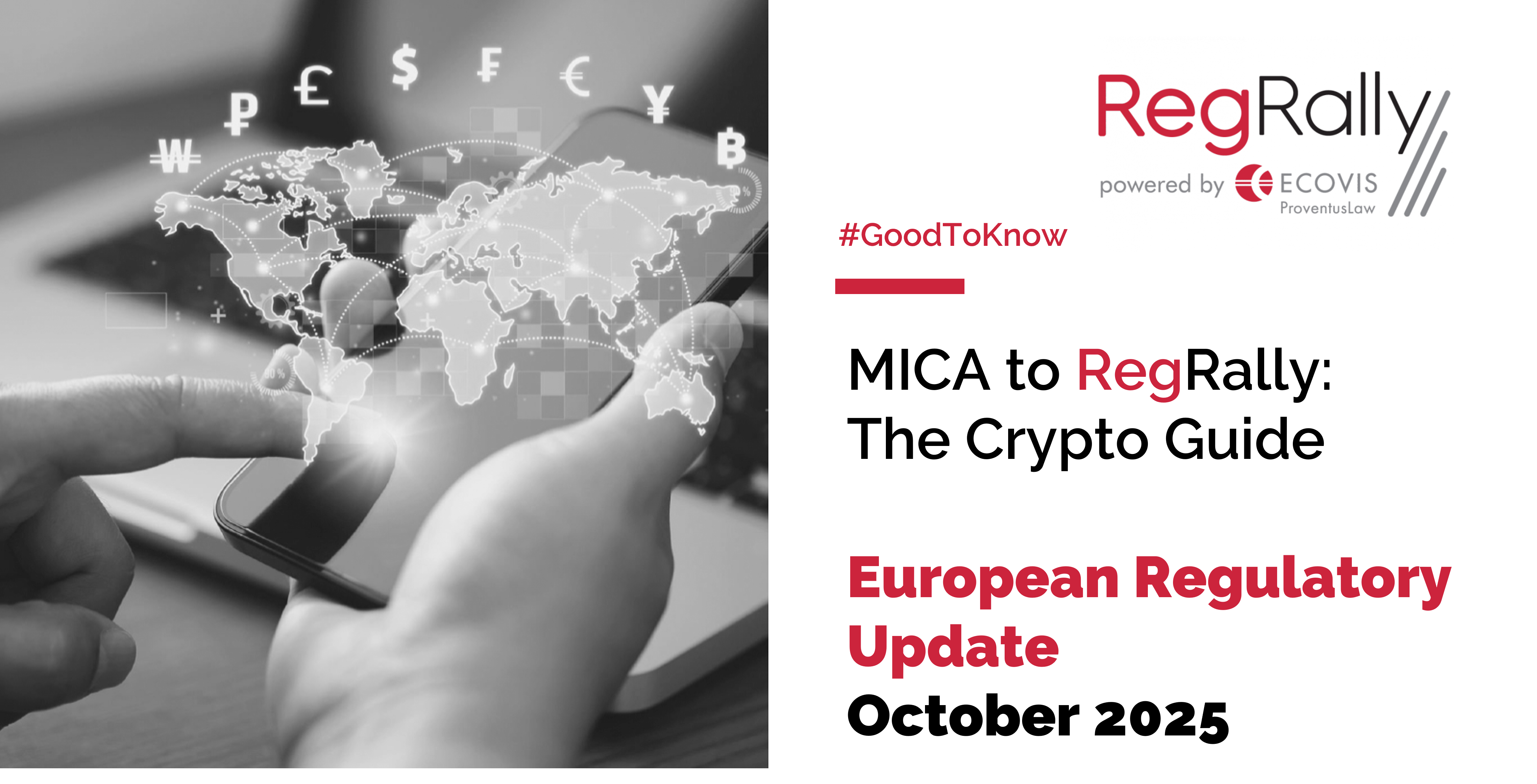ECOVIS ProventusLaw brings you a curated selection of significant developments from the European crypto regulatory landscape in October 2025. It provides viewers a look at what’s ahead and high-profile insights into the ever-changing crypto industry.
Global Report Warns of Rising Market Abuse Risks in Crypto Trading
The Global Finance & Technology Network’s August 2025 report warns that crypto markets face escalating market abuse and manipulation risks, calling for stronger regulatory and institutional safeguards. The study highlights that wash trading, pump-and-dump schemes, flash loan exploitation, and maximal extractable value practices undermine market integrity and investor confidence.
Those arranging or executing crypto trades are urged to establish robust systems to prevent, monitor, and detect abusive practices across both on-chain and off-chain activity. Regulators and market participants should strengthen surveillance, improve transparency, and promote international cooperation to counter these evolving threats.
Key Recommendations
- Strengthen Internal Governance
• Establish clear internal rules and controls to prevent insider trading and ensure disclosure compliance, particularly for token issuance and listings. - Enhance Surveillance Capabilities
• Integrate real-time monitoring and supervisory tools within trading platforms to promptly detect suspicious or manipulative activity. - Align with MiCA Requirements
• Update monitoring frameworks to comply with MiCA Title VI, ensuring the effective capture of both on-chain and off-chain trading environments.
ECB Calls for Tighter Oversight of Foreign Stablecoin Issuers
European Central Bank (ECB) President Christine Lagarde has called on the European Union to close remaining gaps in its stablecoin regulatory framework, stressing that non-EU issuers should not be permitted to operate within the EU unless they meet the same prudential, liquidity, and transparency standards as EU-based entities.
While the MiCA Regulation requires stablecoins to be fully backed, Lagarde warned that foreign issuers may still gain EU market access without equivalent safeguards, posing potential risks to financial stability. In times of market stress, investors could rush to redeem holdings within the EU — where protections are stronger — putting pressure on domestic reserves.
Lagarde urged the establishment of clear equivalence rules, robust cross-border asset safeguards, and stronger international cooperation to prevent regulatory arbitrage and ensure market integrity.
Key Recommendations
1. Strengthen Liquidity and Reserve Management. Review and reinforce liquidity and reserve frameworks to mitigate risks of large-scale redemptions within the EU.
2. Enhance Client Transparency. Update investor communications and disclosures to clearly state that stablecoins are not legal tender and carry inherent redemption and counterparty risks.
3. Monitor Cross-Border Risks. Implement controls to assess the exposure of EU-based firms to non-EU stablecoin issuers and ensure alignment with MiCA prudential standards.
Wolfsberg Group Issues Guidance on Managing Financial Crime Risks in Stablecoin Relationships
The Wolfsberg Group has released new guidance on how banks should manage financial crime risks when dealing with fiat-backed stablecoin issuers. The document confirms that AML/CFT, sanctions, and anti-bribery standards apply as strictly to stablecoins as to traditional finance, highlighting the unique blockchain-specific risks.
Banks providing operating, reserve, or settlement accounts must understand the issuer’s business model, transaction flows, governance, AML, sanctions controls, and blockchain analytics. While banks are not required to monitor every on-chain transaction, they must ensure issuers operate within robust compliance frameworks.
Higher-risk issuers—particularly those active in unregulated markets or connected to decentralised platforms—require enhanced due diligence. The guidance also emphasises reserve transparency, segregation, and close cooperation with regulators and law enforcement.
Recommended actions for financial institutions:
- Review and update onboarding and due diligence processes for fiat-backed stablecoin issuers.
- Align monitoring frameworks with each issuer’s risk profile, governance, and jurisdictional exposure.
- Integrate blockchain analytics into transaction monitoring to complement traditional oversight.
Nine Major European Banks to Launch Euro-Denominated Stablecoin by 2026
Nine leading European banks — including ING, UniCredit, Danske Bank, SEB, CaixaBank, and Raiffeisen — have announced plans to launch a MiCAR-compliant euro stablecoin through a new Netherlands-based entity, expected in the second half of 2026.
The initiative aims to offer a regulated, low-cost, and near-instant payment solution, enhancing cross-border settlement efficiency and enabling programmable payments. The consortium will be licensed and supervised by the Dutch Central Bank as an e-money institution. A CEO appointment is pending, and more banks are expected to join.
This project strengthens Europe’s strategic autonomy in digital finance, positioning the region against U.S.-dominated stablecoins.
Recommended actions for financial institutions:
- Develop strategies to compete and collaborate in a market where bank-issued euro stablecoins coexist with USDT, USDC, and a potential Digital Euro.
- Assess operational readiness for supporting euro stablecoin payments, settlement, and wallet services.
Bank of Italy Flags Risks of Multi-Issuance Stablecoins
The Bank of Italy has raised concerns over multi-issuance stablecoins—identical tokens issued by different branches of the same firm across multiple jurisdictions. Deputy Governor Chiara Scotti highlighted that, while this model can enhance global liquidity, it creates legal, operational, liquidity, and financial stability risks, especially when non-EU issuers are involved and not subject to MiCAR requirements. She recommended restricting issuance to jurisdictions with equivalent regulatory standards, ensuring redemption at par, and establishing cross-jurisdictional crisis protocols to mitigate systemic risk.
The Financial Conduct Authority Consultation Paper CP25/25
The FCA has published Consultation Paper CP25/25, outlining how the FCA Handbook could be applied to regulated crypto-asset activities, signalling a move to bring crypto closer to mainstream financial regulation. Chapters 1–5, which focus on governance, systems and controls, operational resilience, and business standards, are open for consultation until 12 November 2025. Chapters 6–7, covering the Consumer Duty, Financial Ombudsman access, and product governance, close earlier, on 15 October 2025.
The proposals focus on strengthening governance, operational resilience, and consumer protection. They aim to align crypto-asset firms, including those involved in stablecoin issuance, custody, trading, intermediation, and staking, with established regulatory standards.
Nasdaq Seeks SEC Approval to Trade Tokenised Securities
Nasdaq has filed a proposal with the U.S. SEC to allow trading of tokenised securities—digital representations of traditional stocks and ETFs—on its main exchange. This would be the first integration of blockchain-settled securities into the U.S. national market system if approved.
Key points:
- Tokenised securities are intended to carry the same shareholder rights (voting, dividends) as traditional shares, or otherwise be treated separately.
- Trades would run on the existing order book, with order routing, surveillance, and reporting systems unchanged.
- The initiative could streamline settlement and open new opportunities for digital asset adoption in regulated markets.


 Newsletter Subscription
Newsletter Subscription